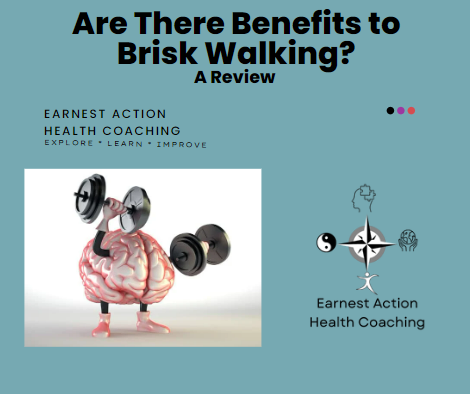Are there benefits to brisk walking? I recently read an article published on IDEAfit.com by Shirley Archer, JD, MA, Benefits of Brisk Walking for the Brain . She mentions a Colorado State University study of 180 adults aged 60-69 who participated in a 6 month study comparing aerobic walking, social dance, and a control group. The study shows an increase in white matter integrity in the brain with better signaling between the brain regions. While this was very informative, I still had questions.
Did I want to know how fast is aerobic walking? How fast would I need to walk to get the benefit? What is the difference between gray and white matter in the brain? How does reduced signaling between the brain regions affect me as I age? What if I started an aerobic walking program at 40 years of age, would it help me preserve my brain better as I age? In this article, I am going to find out how much evidence I can find.
How fast would I need to walk to get the benefit of aerobic walking?
First, walking at any speed is better than not walking at all. In fact, a May 2012 study found as little as 4,400 steps results in lower mortality and reduction in development of diabetes and high blood pressure. Keep in mind more is better. Even if some studies may say benefits level off at 7,500, there’s no reason not to do more if you are able. Here are some links to evidence-based walking programs. Consider starting where you are and tracking your SPM (steps per minute),
Arthritis Foundation, Walk With Ease
American Heart Association, Six Week Beginner Walking Plan
Now back to the speed question. When you are looking to speed up, then 80–112 steps per minute is a good range to work up to. Generally speaking, 3 miles per hour is considered brisk. If you do not have a fitness tracker, time yourself for one minute and count your steps. One hundred (100) steps is about three miles per hour for most people. That being said, I am in fairly good shape at 62 years of age and I need to push to get to this speed. An October 2022 CNBC Make It article summarized two recent studies published in JAMA Neurology and JAMA Internal Medicine by stating that people who walked at least 80 steps reduced their rate of heart disease, cancer, and premature death more than other groups who walked less than 40 SPM (Steps per minute) and 41–79.
What is the difference between gray and white matter in the brain?

When we picture the brain, we normally see the cerebellum with its wrinkly appearance. The edges of the folded brain are like the rind of a melon, but flexible. This rind layer is the gray matter. It contains the synapses and related structures. The gray matter controls the senses and muscular movements. Diseases of gray matter are called neurodegenerative (Alzheimers).
The gray matter needs help communicating with other parts of the brain and spinal cord to execute that control. The white matter contains the axons that allow communication to and from different gray matter areas making fast communication to control functions that we are not aware of. Things like maintaining body temperature, blood pressure, and heart rate, dispensing hormones, food, and emotions. Diseases of the white matter are those that interfere with the signaling of the nerves like Multiple Sclerosis and the hardening of white matter that causes a stroke.
Finally, when the author tells us episodic memory is preserved this means our long term memory used to recall experiences in detail (time, place, and emotions). We all want to be able to remember the best times of our lives as we age.
How does reduced signaling between the brain regions affect me as I age?
Generally, white-matter lesions tend to appear around 60 years of age. The Alzheimer’s Association says 1 in 10 people will develop the disease. The National Institute of Neurological Disorders and Stroke, estimates the chance of a stroke for those 60-65 is 11%. This gives us a general idea of the occurrence of severely reduced signaling between brain regions as white matter lesions normally increase with these conditions.
As you might expect most of us can expect trouble remembering things, slowed thinking, leaking urine (one of those activities we are not aware of), problems walking, and balance issues. As the signals move slower this can be expected.
Not all people who have lesions are impaired in activities of daily life. A March 24, 2003 study published in the American Psychological Association described a study of 327 people. Of the people with hypertension a small but statistically significant number of people had higher lesions. This is consistent with other recent research that seems to indicate better circulation results in fewer white matter lesions. This is the link between faster walking and lower rates of cardiovascular disease and lower blood pressure.
In conclusion, when we walk faster (80-112 steps per minute), we have reduced cardiovascular disease and normally better circulation, and lower blood pressure. Recent studies indicate that better circulation leads to fewer white matter lesions.
Disclaimer. The information provided in this article may not be appropriate for all people. If you are not currently exercising or have or suspect you have conditions like cardiovascular, metabolic or renal disease, then you should consult your physician before considering making any changes suggested.

